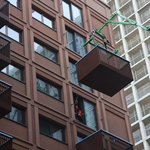simply Dan
Active Member
You don't see very many overhead wires in Montreal... if they can bury them all, certainly Toronto can.
As for the hydro, the pole replacement program is the only way to go in many areas of Toronto. The costs associated with burying new Hydro is ridiculously high as all primary/secondary cables must be installed in concrete encased structures which can be next to impossible in lots of these neighbourhoods due to its size and where it would need to be placed in proximity to existing infrastructure.
That said, it would take nearly forever considering Toronto Hydro has only 3 civil contractors that they use due to expertise, experience and manpower. Another issue with poles is many of them are joint use and are shared with other utilities such as Bell, Rogers, Cogeco, Telus, Allstream, Atria. That said all utilities would have to be relocated at the said time and in agreance with all parties (including BIA, City, etc). There has been many attempts at this in the past but Nimby's have been to blame as they bitch and whine with all the different utility crews needed to complete the work.
Personally, in older neighbourhoods I like the look of wooden poles as it adds character to already distinct areas.
Tewder, your comments about Toronto being 3rd world due to its aerial infrastructure I find funny? Majority of Canada's hydro and telecommunication infrastructure is all aerial. Since you think everything is buried I am going to make the assumption you live in the suburbs??
Only recently is everything buried, such as in new subdivisions due to the introduction of joint use trenching which has only been common in the past 25yrs. Because of coordination between utility providers have they been able to set them up together in order not to take up an overwhelming amount of space underground. This is why they have space constraints with burying new networks downtown as space is already occupied by existing and previosly abandoned utilities. Yes, they may do it in other cities but they do not have the complexity of Toronto's infrastructure. For instance, the NE corner of Bay-Adelaide is the most heavily cabled telecommunications area in North America. The amount of space occupied by the multiples of Bell structures is amazing and something to be marvelled at if ever seen by the eye.
Back to my previous point, most utilities are governed by csa and require both vertical and horizontal clearances. This is all set in place for good reason. You do not want stray voltage jumping from a primary hydro cable to a 16" super high pressure steel gas main just because there is a faulty ground.
Only recently is everything buried, such as in new subdivisions due to the introduction of joint use trenching which has only been common in the past 25yrs.
tza, not to get off topic, but when can we expect bell to start and complete FTTH in toronto?
i hope we hear an announcement soon.
do you think they'll still keep the existing copper infrastructure from the COs to people's homes once fibre comes to town? will we have both copper and fibre service to premises? one for pots, one for internet? or will they scrap the copper lines?
We will not have both copper and fibre services to the house once introduced. When the individual service is replaced to a home it will be a single pr fibre and no copper. For replacement purposes, It will be tricky project as the demarcation boxes on the house, building, etc will have to be replaced to accomadate the fibre (main reason why new construction homes will be the first to have FTTH). Another issue at hand will be a need for fibre splicers for beyond what is currently available. It will definately be interesting to see how the unions and market adapt to these changes. However, do not plan to see copper phased out of the CO's anytime soon.




